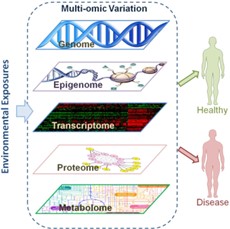In this post, artificial intelligence is discussing the multiomics use and different applications.
Multiomics is a term that refers to the integration and analysis of data from multiple omics disciplines, such as genomics, transcriptomics, proteomics, metabolomics, and epigenomics. Omics disciplines are fields of study that focus on the comprehensive characterization of biological molecules and their interactions in a system. By combining data from different omics levels, multiomics aims to provide a more holistic and accurate understanding of biological systems and their functions. Multiomics has many potential uses in various fields of biology and medicine. Multiomics has many potential uses in various domains of biomedical research and clinical applications.
Multiomics use in biomarker discovery
Multiomics can help identify novel biomarkers that can be used for diagnosis, prognosis, prediction, and monitoring of diseases. Biomarkers are measurable indicators of biological processes or conditions that can reflect the presence or severity of a disease, the response to a treatment, or the risk of developing a disease. For example, multiomics can reveal how gene expression, protein levels, and metabolites change in response to cancer therapy or infection. Multiomics can reveal biomarkers that are not detectable by single omics approaches, or that have synergistic effects across different omics levels.
Disease mechanism elucidation
Multiomics can help uncover the underlying molecular mechanisms that cause or contribute to disease development and progression. By comparing healthy and diseased samples across multiple omics layers, researchers can identify the key genes, proteins, pathways, and networks that are involved in disease pathogenesis.
Disease prevention and management
Multiomics can contribute to disease prevention and management by identifying risk factors, early signs, and causal factors of diseases. Multiomics can also monitor disease progression and response to interventions and suggest preventive or corrective measures to improve health outcomes.
Multiomics use in Drug discovery and development
Multiomics can facilitate the discovery and development of new drugs by providing insights into the molecular mechanisms of diseases, the drug targets and pathways, and the drug effects and side effects. Multiomics can also help optimize drug dosing and delivery, as well as personalize drug therapy based on individual omics profiles.
Precision medicine
Multiomics can enable precision medicine, which is an approach that tailors medical interventions to the specific characteristics of each patient. Precision medicine can improve the efficacy and safety of treatments, as well as prevent or delay the onset of diseases. Multiomics can help stratify patients into subgroups based on their omics signatures and provide guidance for selecting the best treatment options for each subgroup.
Non-medical multiomics use
Multiomics is not limited to medical applications. In fact, multiomics can be applied to various non-medical domains, such as agriculture, biotechnology, ecology, environmental science, food science, and forensic science. One of the main benefits of using multiomics in non-medical contexts is that it can reveal novel insights and discoveries that would not be possible by using single-omics approaches. For example, multiomics can help identify new biomarkers, pathways, mechanisms, and interactions that are relevant for a specific biological system or process. Multiomics can also help validate and refine existing hypotheses and models by providing more comprehensive and accurate data.
Another benefit of using multiomics in non-medical contexts is that it can enhance the quality and efficiency of decision making and problem solving. For example, multiomics can help optimize the design and performance of biotechnological products and processes by providing more information about the molecular characteristics and functions of the biological components involved. Multiomics can also help monitor and evaluate the impact and outcome of interventions and treatments by providing more data about the changes and responses of the biological system.
Conclusion
Multiomics is a promising and rapidly evolving approach that has the potential to revolutionize biomedical research and clinical practice. However, multiomics also faces many challenges and limitations, such as data integration, interpretation, standardization, reproducibility, and ethical issues. Therefore, multiomics requires interdisciplinary collaboration, advanced computational methods, robust experimental designs, and careful ethical considerations to achieve its full potential.
See also:

Pingback: How To Better Treat Cancer: Cancer Omics - Bioinformatics Hub